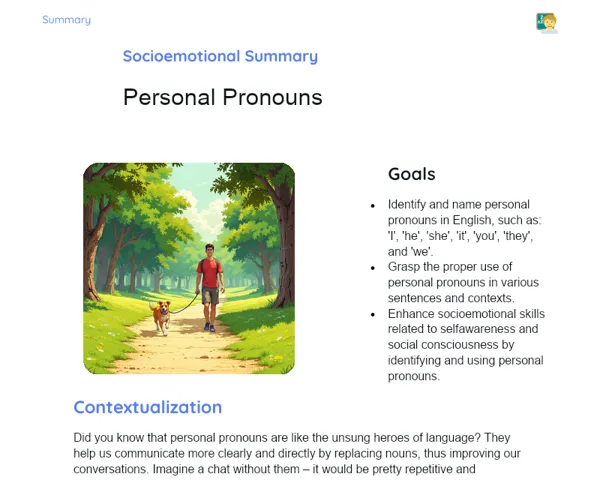Socioemotional Summary Conclusion
Goals
1. Recognise the use of the imperative in English for giving orders, instructions, making requests, and offering advice.
2. Understand the reasons behind using the imperative and the effects it has in different communication situations.
3. Develop the ability to express oneself clearly and appropriately using the imperative.
Contextualization
📬📣 Have you ever thought about how a simple command can shift the atmosphere of a conversation? In English, the imperative is our go-to form for issuing orders, giving instructions, making requests, and even offering advice. Picture yourself in a bustling English-speaking place, asking for directions or guiding someone – mastering the imperative can be the key to communicating clearly and effectively, as well as a fantastic way to express your feelings and intentions! Let’s embark on this journey together and learn to use the imperative with confidence and flair! 🚀
Exercising Your Knowledge
What is the Imperative in English?
The imperative is a powerful and straightforward form used to issue commands, instructions, requests, and advice. In English, it allows us to communicate assertively and clearly, often dropping the subject of the sentence, making our communication quicker and more efficient.
-
Direct Use: The imperative is used without the subject. Example: 'Close the door.'
-
Clear Intention: Conveys intention assertively and immediately.
-
Diversity of Applications: It can be employed in various situations, from direct orders to offering advice.
Forming the Imperative
Creating the imperative in English is quite simple, but the tone and word choice can significantly alter how the message is perceived. This ease masks a wealth of emotional and contextual subtleties.
-
Affirmative: Formed by using the base of the verb without the subject. Example: 'Open the door.'
-
Negative: Formed by placing 'do not' or 'don't' before the verb. Example: 'Don't open the door.'
-
Importance of Tone: The tone can transform a command into a polite request or a firm instruction.
Uses of the Imperative
The imperative is incredibly versatile and can be utilised in various ways, with each use carrying a specific intention that influences how the recipient reacts emotionally.
-
Orders: Used to directly instruct someone. Example: 'Sit down.'
-
Instructions: Used to guide someone through a task or direction. Example: 'Turn left at the corner.'
-
Requests: Polite forms to ask for something. Example: 'Please, pass the salt.'
-
Advice: Suggestions for future actions. Example: 'Take an umbrella with you.'
Tones of the Imperative
The tone in which the imperative is used can drastically change the message conveyed, affecting interpersonal relationships and emotions. Using the right tone is key for effective and harmonious communication.
-
Polite: 'Please, close the window.' - A more gentle and respectful approach.
-
Kind: 'Take care.' - Shows genuine care and concern.
-
Assertive: 'Finish your homework.' - Direct and clear, focusing on action.
-
Rude: 'Shut up!' - Can lead to misunderstandings and conflict.
Key Terms
-
Imperative
-
Affirmative
-
Negative
-
Tone of Voice
-
Instructions
-
Orders
-
Requests
-
Advice
For Reflection
-
How does the tone of voice we use when issuing a command influence the emotional reaction of the other person?
-
Can you recall a time when you received a direct order? How did it make you feel, and why?
-
How can you use the imperative to provide advice in a way that supports and respects the receiver?
Important Conclusions
-
The imperative in English serves as a powerful tool for giving orders, instructions, making requests, and offering advice.
-
The tone and choice of words when using the imperative can significantly change how the message is perceived.
-
Mastering the imperative not only enhances communication in English but also develops socio-emotional skills such as assertiveness and empathy.
Impacts on Society
Using the imperative appropriately directly affects our daily communication, helping to clarify instructions and requests, which is crucial in settings such as schools, workplaces, and families. The ability to give commands kindly and effectively fosters cooperation and respect, creating more collaborative environments.
In a wider context, a well-rounded understanding of the imperative and its conscious application can diminish conflicts and misunderstandings, allowing for healthier communication. By grasping how our tone and word choices affect those around us, we cultivate greater social awareness and emotional sensitivity necessary for nurturing positive interpersonal relationships.
Dealing with Emotions
To help you manage your emotions while learning and applying the imperative, I propose an exercise based on the RULER method. First, identify the emotions you experience when giving or receiving commands - it could be nervousness, confidence, or even frustration. Next, think about what triggers those feelings - perhaps it’s the tone of voice or the scenario itself. Label those emotions accurately and reflect on how you articulated them during practice. Finally, consider strategies to effectively regulate these emotions, like taking a deep breath before speaking or using gentler phrases in tense situations.
Study Tips
-
Create flashcards with different commands and practice varying the tone for each one.
-
Record yourself giving commands and listen back to assess how your tone influences the meaning.
-
Team up with a study partner, alternately giving and receiving commands, and discuss how each of you felt in every scenario.


